Case Study on Training Program
VerifiedAdded on 2023/04/21
|9
|1732
|430
AI Summary
This case study focuses on the training need analysis for performance improvement in the workplace. It discusses the introduction of departmental training, human resource training, English classes for improving communication, cross-exposure training, and the importance of departmental trainers.
Contribute Materials
Your contribution can guide someone’s learning journey. Share your
documents today.
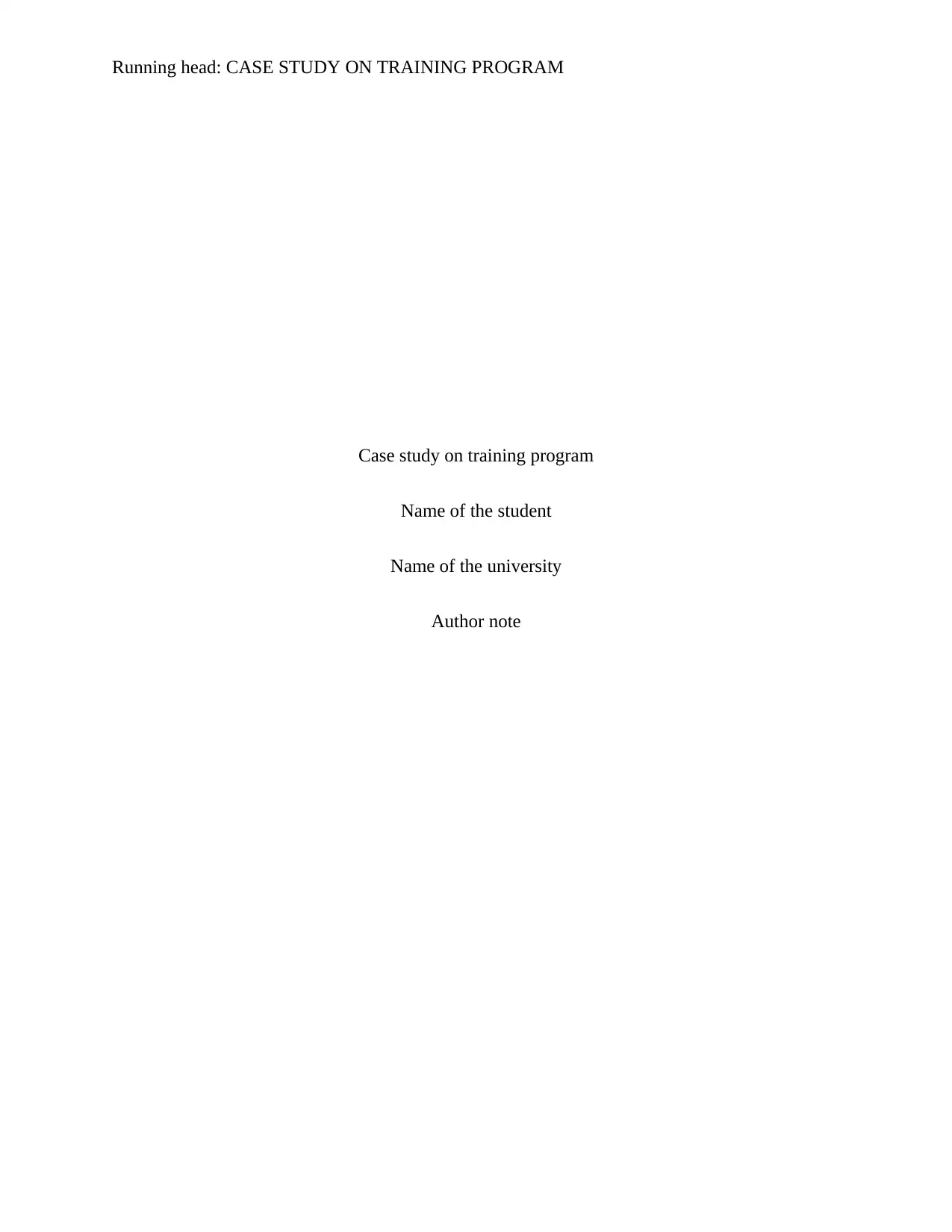
Running head: CASE STUDY ON TRAINING PROGRAM
Case study on training program
Name of the student
Name of the university
Author note
Case study on training program
Name of the student
Name of the university
Author note
Secure Best Marks with AI Grader
Need help grading? Try our AI Grader for instant feedback on your assignments.
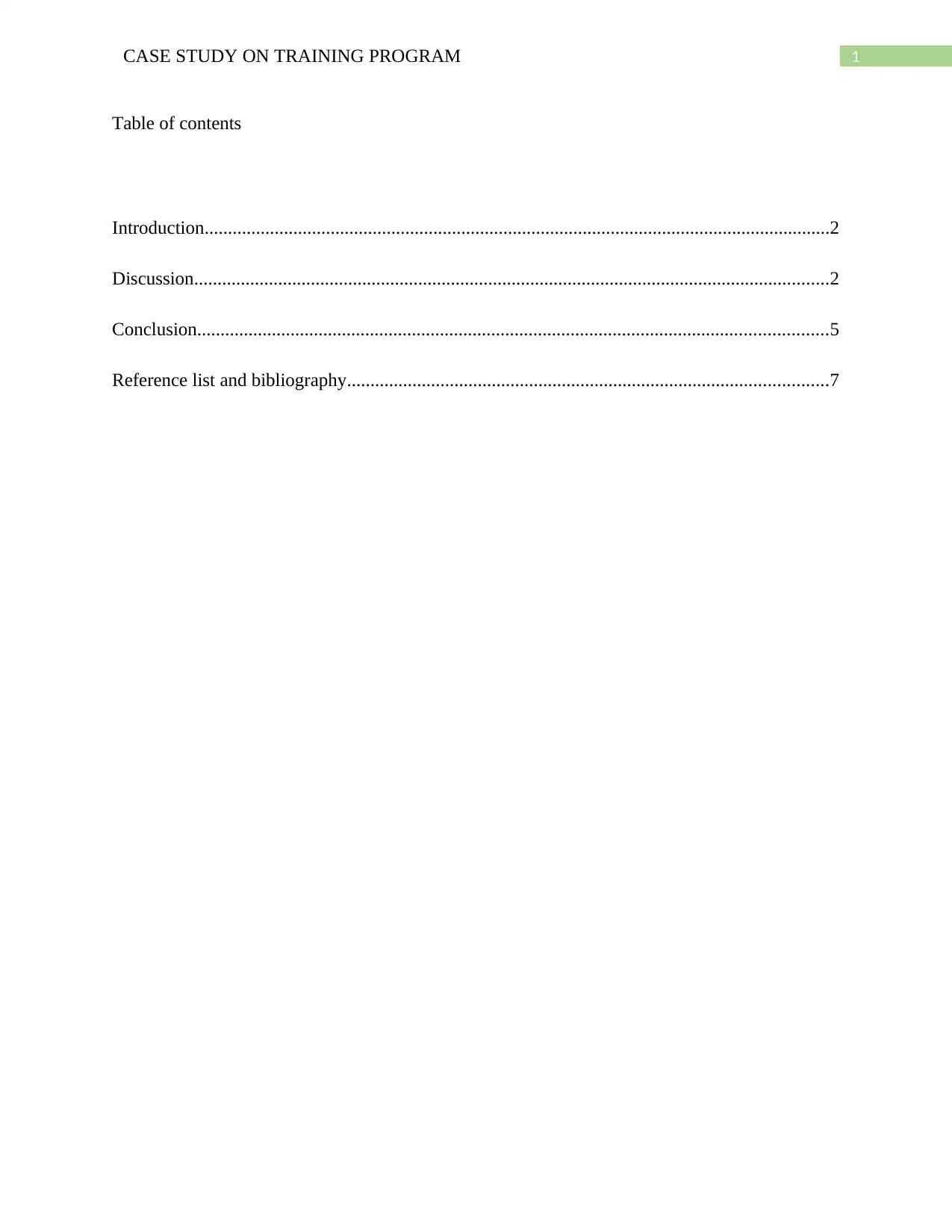
1CASE STUDY ON TRAINING PROGRAM
Table of contents
Introduction......................................................................................................................................2
Discussion........................................................................................................................................2
Conclusion.......................................................................................................................................5
Reference list and bibliography.......................................................................................................7
Table of contents
Introduction......................................................................................................................................2
Discussion........................................................................................................................................2
Conclusion.......................................................................................................................................5
Reference list and bibliography.......................................................................................................7
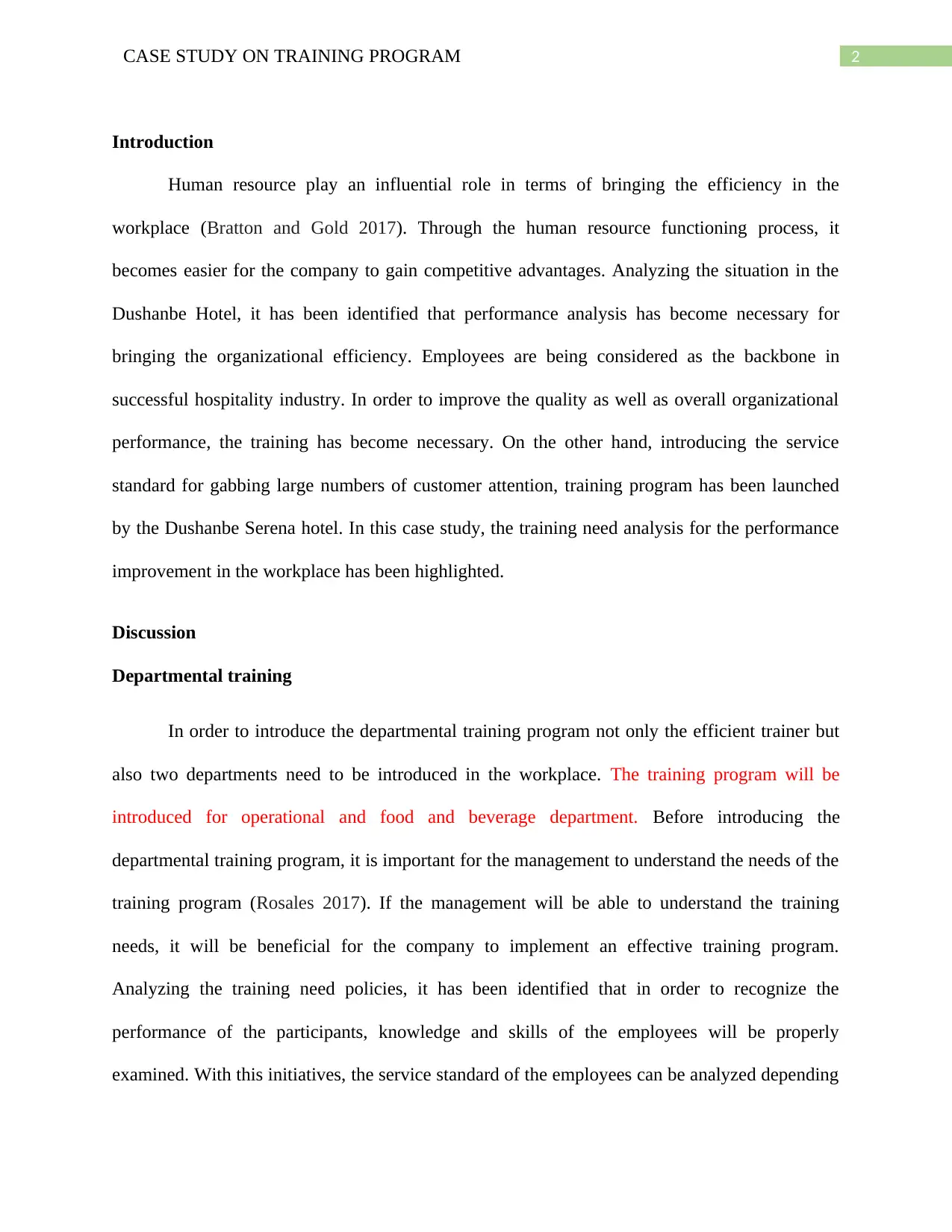
2CASE STUDY ON TRAINING PROGRAM
Introduction
Human resource play an influential role in terms of bringing the efficiency in the
workplace (Bratton and Gold 2017). Through the human resource functioning process, it
becomes easier for the company to gain competitive advantages. Analyzing the situation in the
Dushanbe Hotel, it has been identified that performance analysis has become necessary for
bringing the organizational efficiency. Employees are being considered as the backbone in
successful hospitality industry. In order to improve the quality as well as overall organizational
performance, the training has become necessary. On the other hand, introducing the service
standard for gabbing large numbers of customer attention, training program has been launched
by the Dushanbe Serena hotel. In this case study, the training need analysis for the performance
improvement in the workplace has been highlighted.
Discussion
Departmental training
In order to introduce the departmental training program not only the efficient trainer but
also two departments need to be introduced in the workplace. The training program will be
introduced for operational and food and beverage department. Before introducing the
departmental training program, it is important for the management to understand the needs of the
training program (Rosales 2017). If the management will be able to understand the training
needs, it will be beneficial for the company to implement an effective training program.
Analyzing the training need policies, it has been identified that in order to recognize the
performance of the participants, knowledge and skills of the employees will be properly
examined. With this initiatives, the service standard of the employees can be analyzed depending
Introduction
Human resource play an influential role in terms of bringing the efficiency in the
workplace (Bratton and Gold 2017). Through the human resource functioning process, it
becomes easier for the company to gain competitive advantages. Analyzing the situation in the
Dushanbe Hotel, it has been identified that performance analysis has become necessary for
bringing the organizational efficiency. Employees are being considered as the backbone in
successful hospitality industry. In order to improve the quality as well as overall organizational
performance, the training has become necessary. On the other hand, introducing the service
standard for gabbing large numbers of customer attention, training program has been launched
by the Dushanbe Serena hotel. In this case study, the training need analysis for the performance
improvement in the workplace has been highlighted.
Discussion
Departmental training
In order to introduce the departmental training program not only the efficient trainer but
also two departments need to be introduced in the workplace. The training program will be
introduced for operational and food and beverage department. Before introducing the
departmental training program, it is important for the management to understand the needs of the
training program (Rosales 2017). If the management will be able to understand the training
needs, it will be beneficial for the company to implement an effective training program.
Analyzing the training need policies, it has been identified that in order to recognize the
performance of the participants, knowledge and skills of the employees will be properly
examined. With this initiatives, the service standard of the employees can be analyzed depending
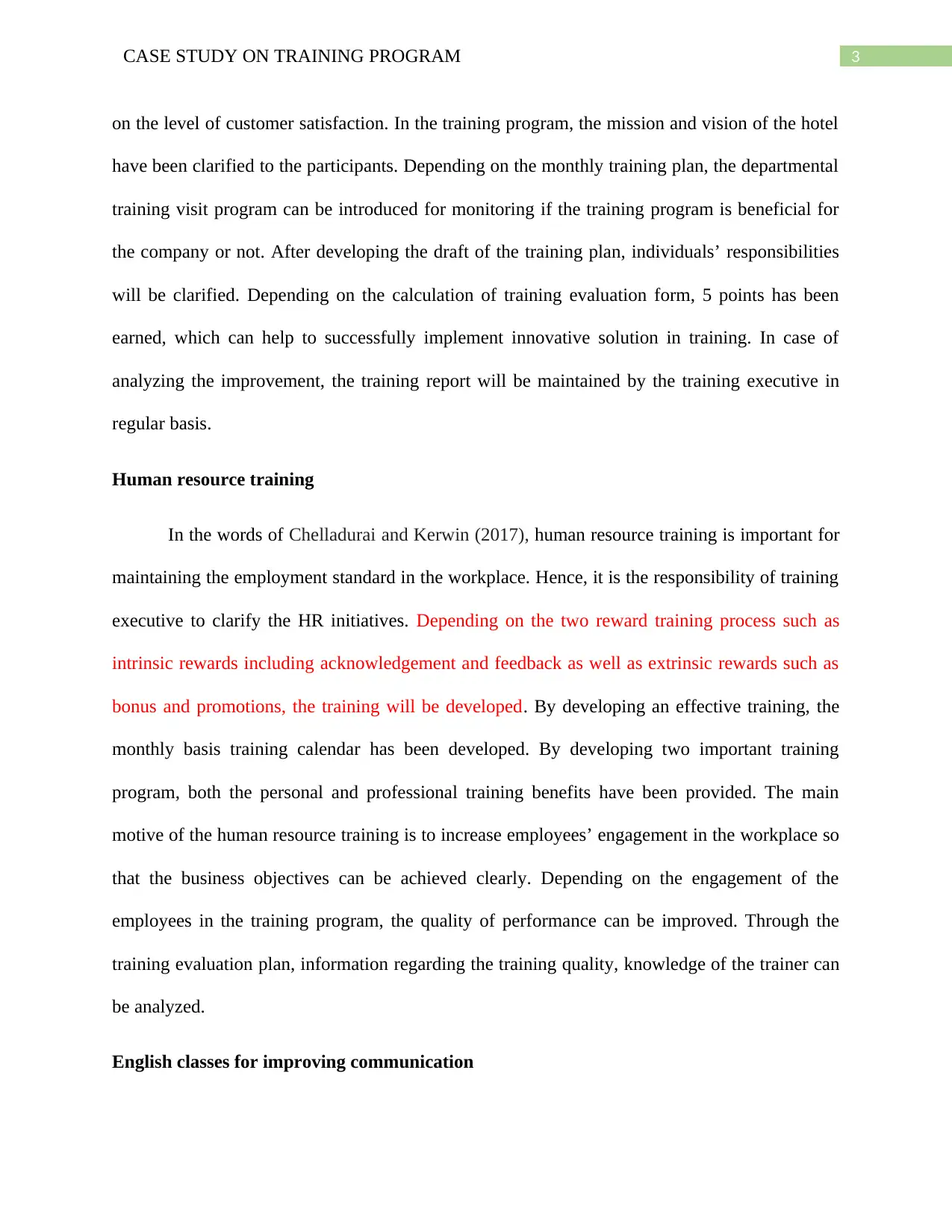
3CASE STUDY ON TRAINING PROGRAM
on the level of customer satisfaction. In the training program, the mission and vision of the hotel
have been clarified to the participants. Depending on the monthly training plan, the departmental
training visit program can be introduced for monitoring if the training program is beneficial for
the company or not. After developing the draft of the training plan, individuals’ responsibilities
will be clarified. Depending on the calculation of training evaluation form, 5 points has been
earned, which can help to successfully implement innovative solution in training. In case of
analyzing the improvement, the training report will be maintained by the training executive in
regular basis.
Human resource training
In the words of Chelladurai and Kerwin (2017), human resource training is important for
maintaining the employment standard in the workplace. Hence, it is the responsibility of training
executive to clarify the HR initiatives. Depending on the two reward training process such as
intrinsic rewards including acknowledgement and feedback as well as extrinsic rewards such as
bonus and promotions, the training will be developed. By developing an effective training, the
monthly basis training calendar has been developed. By developing two important training
program, both the personal and professional training benefits have been provided. The main
motive of the human resource training is to increase employees’ engagement in the workplace so
that the business objectives can be achieved clearly. Depending on the engagement of the
employees in the training program, the quality of performance can be improved. Through the
training evaluation plan, information regarding the training quality, knowledge of the trainer can
be analyzed.
English classes for improving communication
on the level of customer satisfaction. In the training program, the mission and vision of the hotel
have been clarified to the participants. Depending on the monthly training plan, the departmental
training visit program can be introduced for monitoring if the training program is beneficial for
the company or not. After developing the draft of the training plan, individuals’ responsibilities
will be clarified. Depending on the calculation of training evaluation form, 5 points has been
earned, which can help to successfully implement innovative solution in training. In case of
analyzing the improvement, the training report will be maintained by the training executive in
regular basis.
Human resource training
In the words of Chelladurai and Kerwin (2017), human resource training is important for
maintaining the employment standard in the workplace. Hence, it is the responsibility of training
executive to clarify the HR initiatives. Depending on the two reward training process such as
intrinsic rewards including acknowledgement and feedback as well as extrinsic rewards such as
bonus and promotions, the training will be developed. By developing an effective training, the
monthly basis training calendar has been developed. By developing two important training
program, both the personal and professional training benefits have been provided. The main
motive of the human resource training is to increase employees’ engagement in the workplace so
that the business objectives can be achieved clearly. Depending on the engagement of the
employees in the training program, the quality of performance can be improved. Through the
training evaluation plan, information regarding the training quality, knowledge of the trainer can
be analyzed.
English classes for improving communication
Secure Best Marks with AI Grader
Need help grading? Try our AI Grader for instant feedback on your assignments.
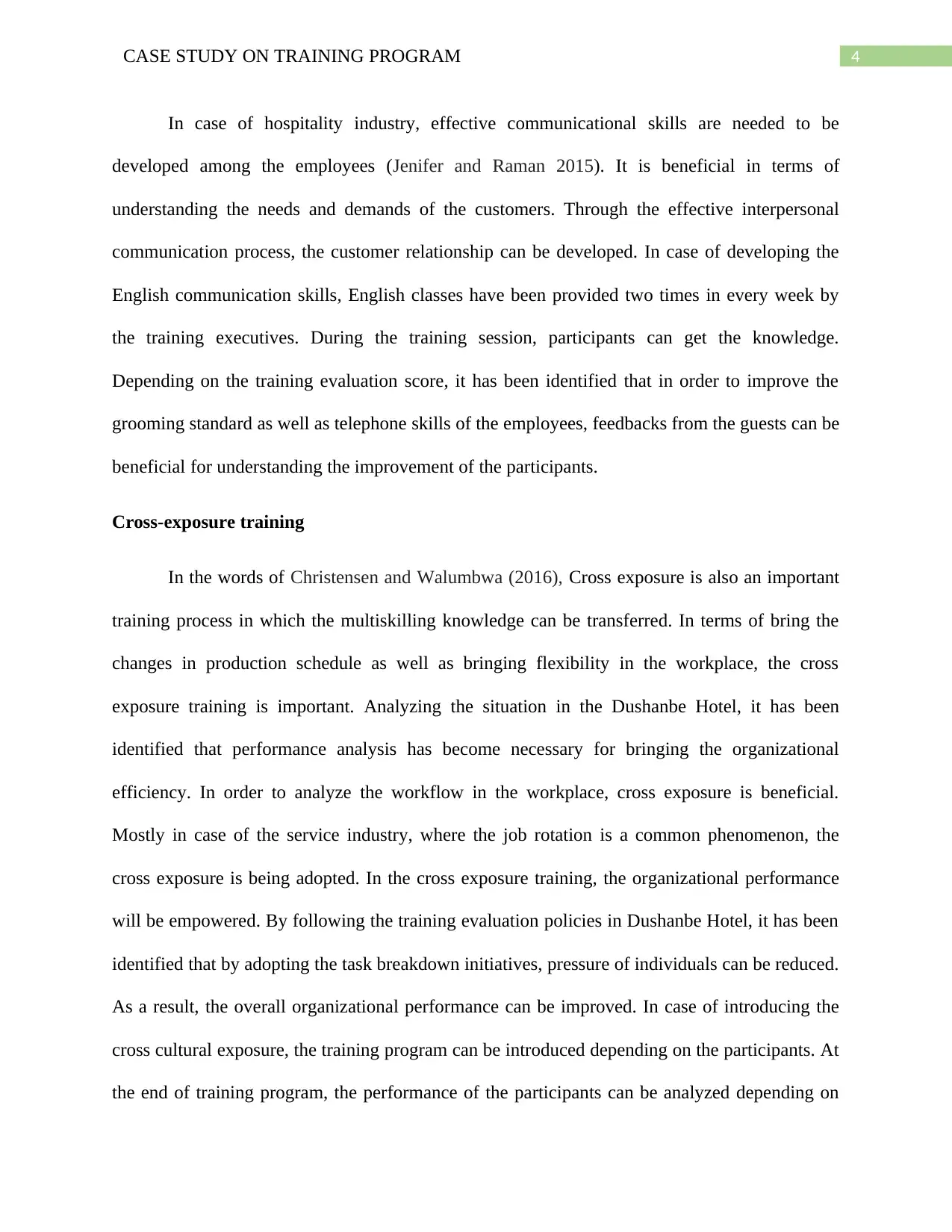
4CASE STUDY ON TRAINING PROGRAM
In case of hospitality industry, effective communicational skills are needed to be
developed among the employees (Jenifer and Raman 2015). It is beneficial in terms of
understanding the needs and demands of the customers. Through the effective interpersonal
communication process, the customer relationship can be developed. In case of developing the
English communication skills, English classes have been provided two times in every week by
the training executives. During the training session, participants can get the knowledge.
Depending on the training evaluation score, it has been identified that in order to improve the
grooming standard as well as telephone skills of the employees, feedbacks from the guests can be
beneficial for understanding the improvement of the participants.
Cross-exposure training
In the words of Christensen and Walumbwa (2016), Cross exposure is also an important
training process in which the multiskilling knowledge can be transferred. In terms of bring the
changes in production schedule as well as bringing flexibility in the workplace, the cross
exposure training is important. Analyzing the situation in the Dushanbe Hotel, it has been
identified that performance analysis has become necessary for bringing the organizational
efficiency. In order to analyze the workflow in the workplace, cross exposure is beneficial.
Mostly in case of the service industry, where the job rotation is a common phenomenon, the
cross exposure is being adopted. In the cross exposure training, the organizational performance
will be empowered. By following the training evaluation policies in Dushanbe Hotel, it has been
identified that by adopting the task breakdown initiatives, pressure of individuals can be reduced.
As a result, the overall organizational performance can be improved. In case of introducing the
cross cultural exposure, the training program can be introduced depending on the participants. At
the end of training program, the performance of the participants can be analyzed depending on
In case of hospitality industry, effective communicational skills are needed to be
developed among the employees (Jenifer and Raman 2015). It is beneficial in terms of
understanding the needs and demands of the customers. Through the effective interpersonal
communication process, the customer relationship can be developed. In case of developing the
English communication skills, English classes have been provided two times in every week by
the training executives. During the training session, participants can get the knowledge.
Depending on the training evaluation score, it has been identified that in order to improve the
grooming standard as well as telephone skills of the employees, feedbacks from the guests can be
beneficial for understanding the improvement of the participants.
Cross-exposure training
In the words of Christensen and Walumbwa (2016), Cross exposure is also an important
training process in which the multiskilling knowledge can be transferred. In terms of bring the
changes in production schedule as well as bringing flexibility in the workplace, the cross
exposure training is important. Analyzing the situation in the Dushanbe Hotel, it has been
identified that performance analysis has become necessary for bringing the organizational
efficiency. In order to analyze the workflow in the workplace, cross exposure is beneficial.
Mostly in case of the service industry, where the job rotation is a common phenomenon, the
cross exposure is being adopted. In the cross exposure training, the organizational performance
will be empowered. By following the training evaluation policies in Dushanbe Hotel, it has been
identified that by adopting the task breakdown initiatives, pressure of individuals can be reduced.
As a result, the overall organizational performance can be improved. In case of introducing the
cross cultural exposure, the training program can be introduced depending on the participants. At
the end of training program, the performance of the participants can be analyzed depending on
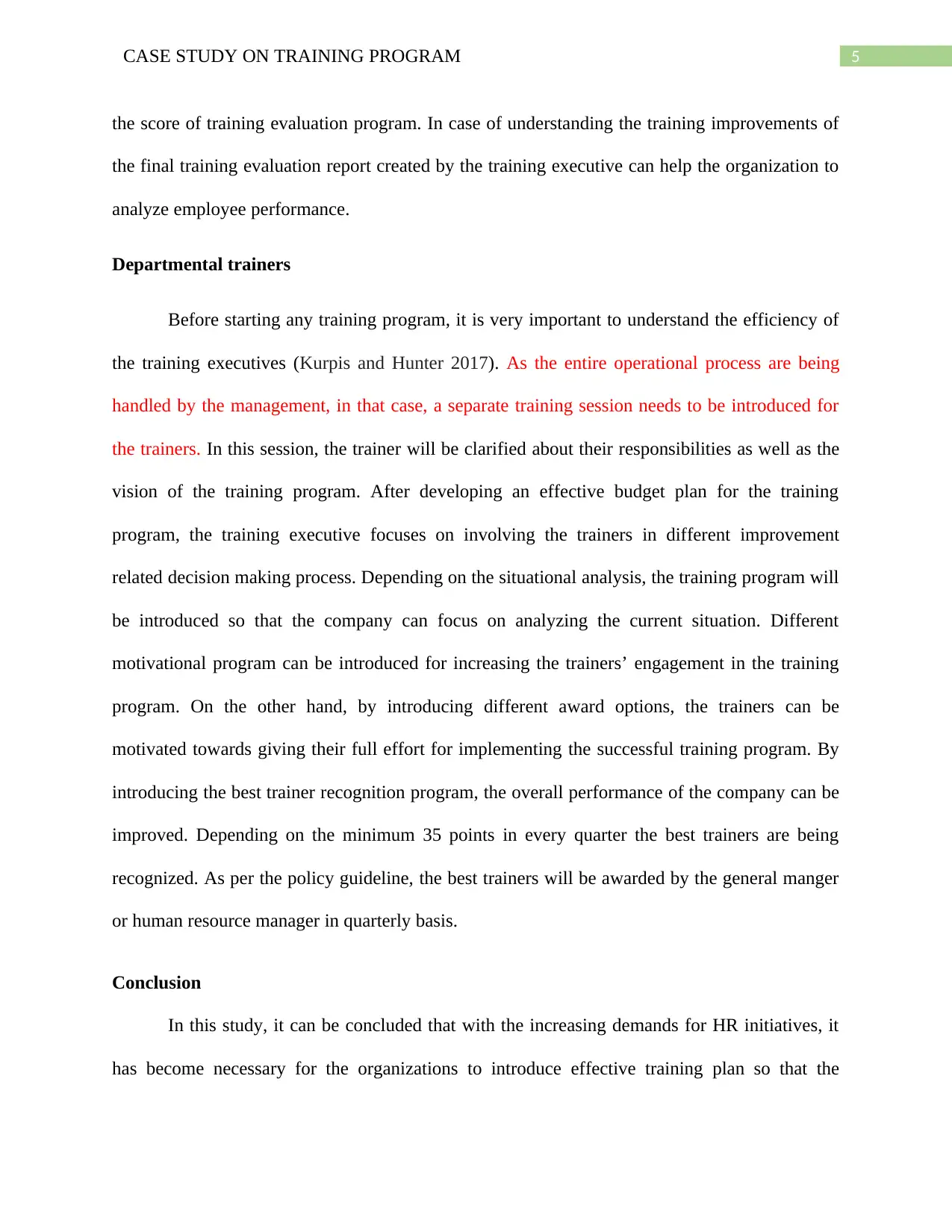
5CASE STUDY ON TRAINING PROGRAM
the score of training evaluation program. In case of understanding the training improvements of
the final training evaluation report created by the training executive can help the organization to
analyze employee performance.
Departmental trainers
Before starting any training program, it is very important to understand the efficiency of
the training executives (Kurpis and Hunter 2017). As the entire operational process are being
handled by the management, in that case, a separate training session needs to be introduced for
the trainers. In this session, the trainer will be clarified about their responsibilities as well as the
vision of the training program. After developing an effective budget plan for the training
program, the training executive focuses on involving the trainers in different improvement
related decision making process. Depending on the situational analysis, the training program will
be introduced so that the company can focus on analyzing the current situation. Different
motivational program can be introduced for increasing the trainers’ engagement in the training
program. On the other hand, by introducing different award options, the trainers can be
motivated towards giving their full effort for implementing the successful training program. By
introducing the best trainer recognition program, the overall performance of the company can be
improved. Depending on the minimum 35 points in every quarter the best trainers are being
recognized. As per the policy guideline, the best trainers will be awarded by the general manger
or human resource manager in quarterly basis.
Conclusion
In this study, it can be concluded that with the increasing demands for HR initiatives, it
has become necessary for the organizations to introduce effective training plan so that the
the score of training evaluation program. In case of understanding the training improvements of
the final training evaluation report created by the training executive can help the organization to
analyze employee performance.
Departmental trainers
Before starting any training program, it is very important to understand the efficiency of
the training executives (Kurpis and Hunter 2017). As the entire operational process are being
handled by the management, in that case, a separate training session needs to be introduced for
the trainers. In this session, the trainer will be clarified about their responsibilities as well as the
vision of the training program. After developing an effective budget plan for the training
program, the training executive focuses on involving the trainers in different improvement
related decision making process. Depending on the situational analysis, the training program will
be introduced so that the company can focus on analyzing the current situation. Different
motivational program can be introduced for increasing the trainers’ engagement in the training
program. On the other hand, by introducing different award options, the trainers can be
motivated towards giving their full effort for implementing the successful training program. By
introducing the best trainer recognition program, the overall performance of the company can be
improved. Depending on the minimum 35 points in every quarter the best trainers are being
recognized. As per the policy guideline, the best trainers will be awarded by the general manger
or human resource manager in quarterly basis.
Conclusion
In this study, it can be concluded that with the increasing demands for HR initiatives, it
has become necessary for the organizations to introduce effective training plan so that the
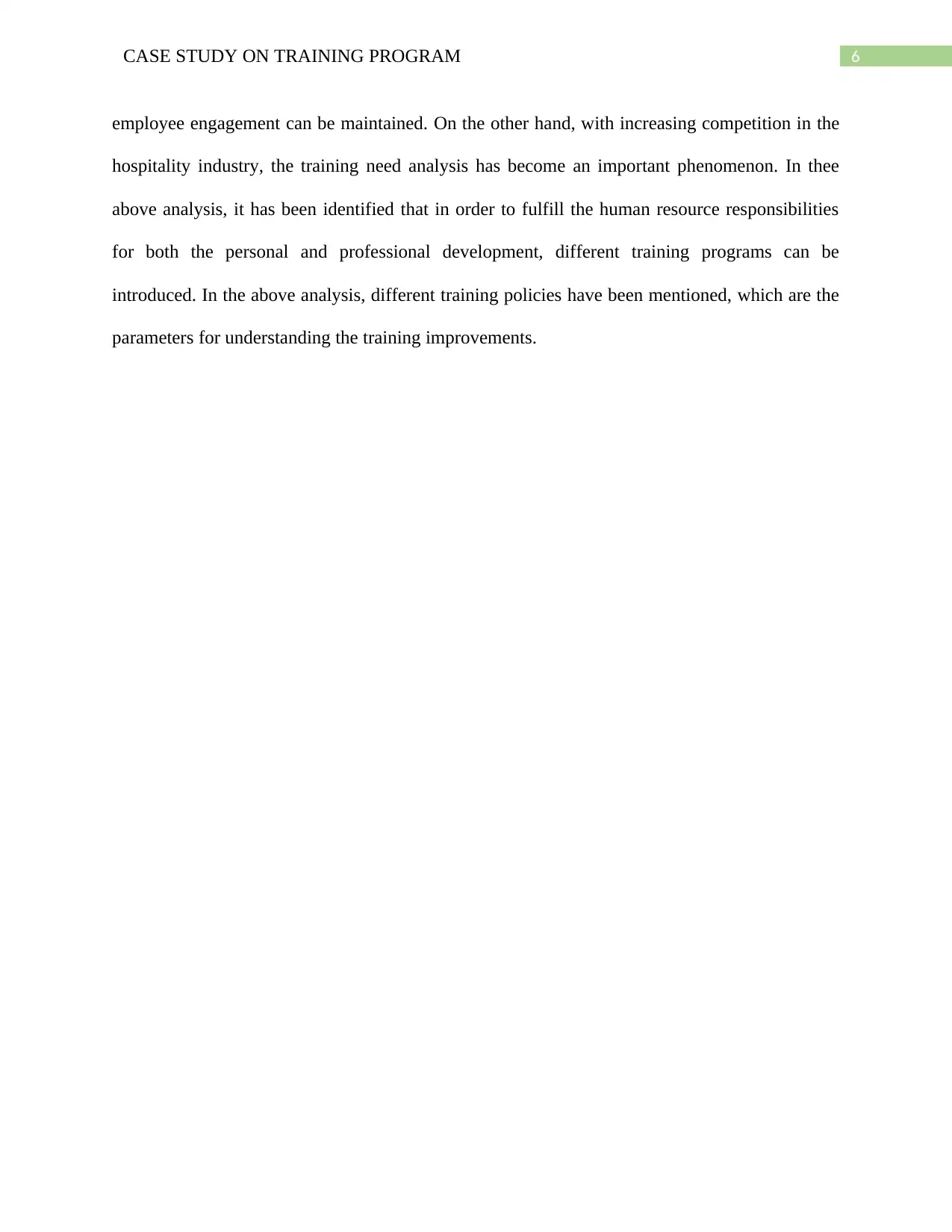
6CASE STUDY ON TRAINING PROGRAM
employee engagement can be maintained. On the other hand, with increasing competition in the
hospitality industry, the training need analysis has become an important phenomenon. In thee
above analysis, it has been identified that in order to fulfill the human resource responsibilities
for both the personal and professional development, different training programs can be
introduced. In the above analysis, different training policies have been mentioned, which are the
parameters for understanding the training improvements.
employee engagement can be maintained. On the other hand, with increasing competition in the
hospitality industry, the training need analysis has become an important phenomenon. In thee
above analysis, it has been identified that in order to fulfill the human resource responsibilities
for both the personal and professional development, different training programs can be
introduced. In the above analysis, different training policies have been mentioned, which are the
parameters for understanding the training improvements.
Paraphrase This Document
Need a fresh take? Get an instant paraphrase of this document with our AI Paraphraser
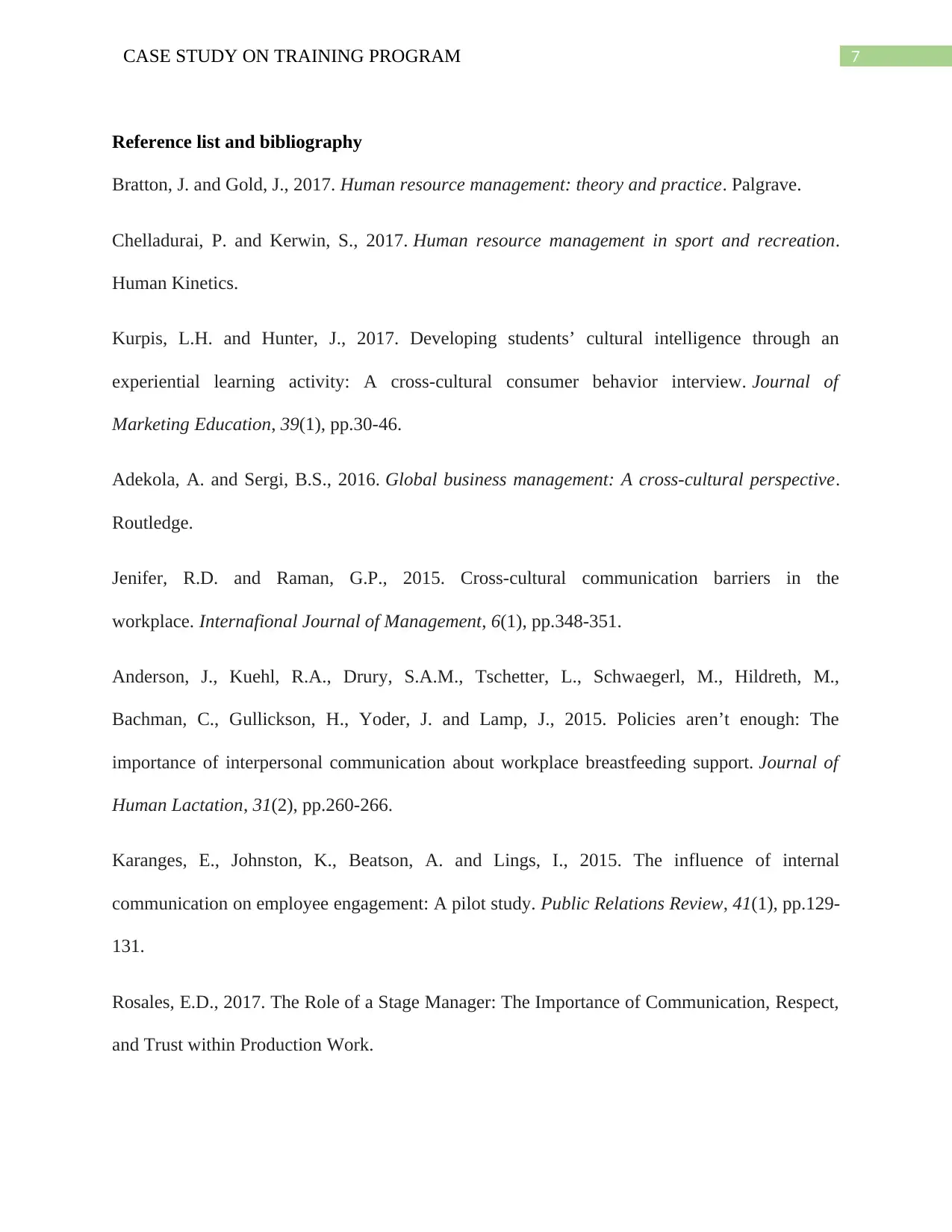
7CASE STUDY ON TRAINING PROGRAM
Reference list and bibliography
Bratton, J. and Gold, J., 2017. Human resource management: theory and practice. Palgrave.
Chelladurai, P. and Kerwin, S., 2017. Human resource management in sport and recreation.
Human Kinetics.
Kurpis, L.H. and Hunter, J., 2017. Developing students’ cultural intelligence through an
experiential learning activity: A cross-cultural consumer behavior interview. Journal of
Marketing Education, 39(1), pp.30-46.
Adekola, A. and Sergi, B.S., 2016. Global business management: A cross-cultural perspective.
Routledge.
Jenifer, R.D. and Raman, G.P., 2015. Cross-cultural communication barriers in the
workplace. Internafional Journal of Management, 6(1), pp.348-351.
Anderson, J., Kuehl, R.A., Drury, S.A.M., Tschetter, L., Schwaegerl, M., Hildreth, M.,
Bachman, C., Gullickson, H., Yoder, J. and Lamp, J., 2015. Policies aren’t enough: The
importance of interpersonal communication about workplace breastfeeding support. Journal of
Human Lactation, 31(2), pp.260-266.
Karanges, E., Johnston, K., Beatson, A. and Lings, I., 2015. The influence of internal
communication on employee engagement: A pilot study. Public Relations Review, 41(1), pp.129-
131.
Rosales, E.D., 2017. The Role of a Stage Manager: The Importance of Communication, Respect,
and Trust within Production Work.
Reference list and bibliography
Bratton, J. and Gold, J., 2017. Human resource management: theory and practice. Palgrave.
Chelladurai, P. and Kerwin, S., 2017. Human resource management in sport and recreation.
Human Kinetics.
Kurpis, L.H. and Hunter, J., 2017. Developing students’ cultural intelligence through an
experiential learning activity: A cross-cultural consumer behavior interview. Journal of
Marketing Education, 39(1), pp.30-46.
Adekola, A. and Sergi, B.S., 2016. Global business management: A cross-cultural perspective.
Routledge.
Jenifer, R.D. and Raman, G.P., 2015. Cross-cultural communication barriers in the
workplace. Internafional Journal of Management, 6(1), pp.348-351.
Anderson, J., Kuehl, R.A., Drury, S.A.M., Tschetter, L., Schwaegerl, M., Hildreth, M.,
Bachman, C., Gullickson, H., Yoder, J. and Lamp, J., 2015. Policies aren’t enough: The
importance of interpersonal communication about workplace breastfeeding support. Journal of
Human Lactation, 31(2), pp.260-266.
Karanges, E., Johnston, K., Beatson, A. and Lings, I., 2015. The influence of internal
communication on employee engagement: A pilot study. Public Relations Review, 41(1), pp.129-
131.
Rosales, E.D., 2017. The Role of a Stage Manager: The Importance of Communication, Respect,
and Trust within Production Work.
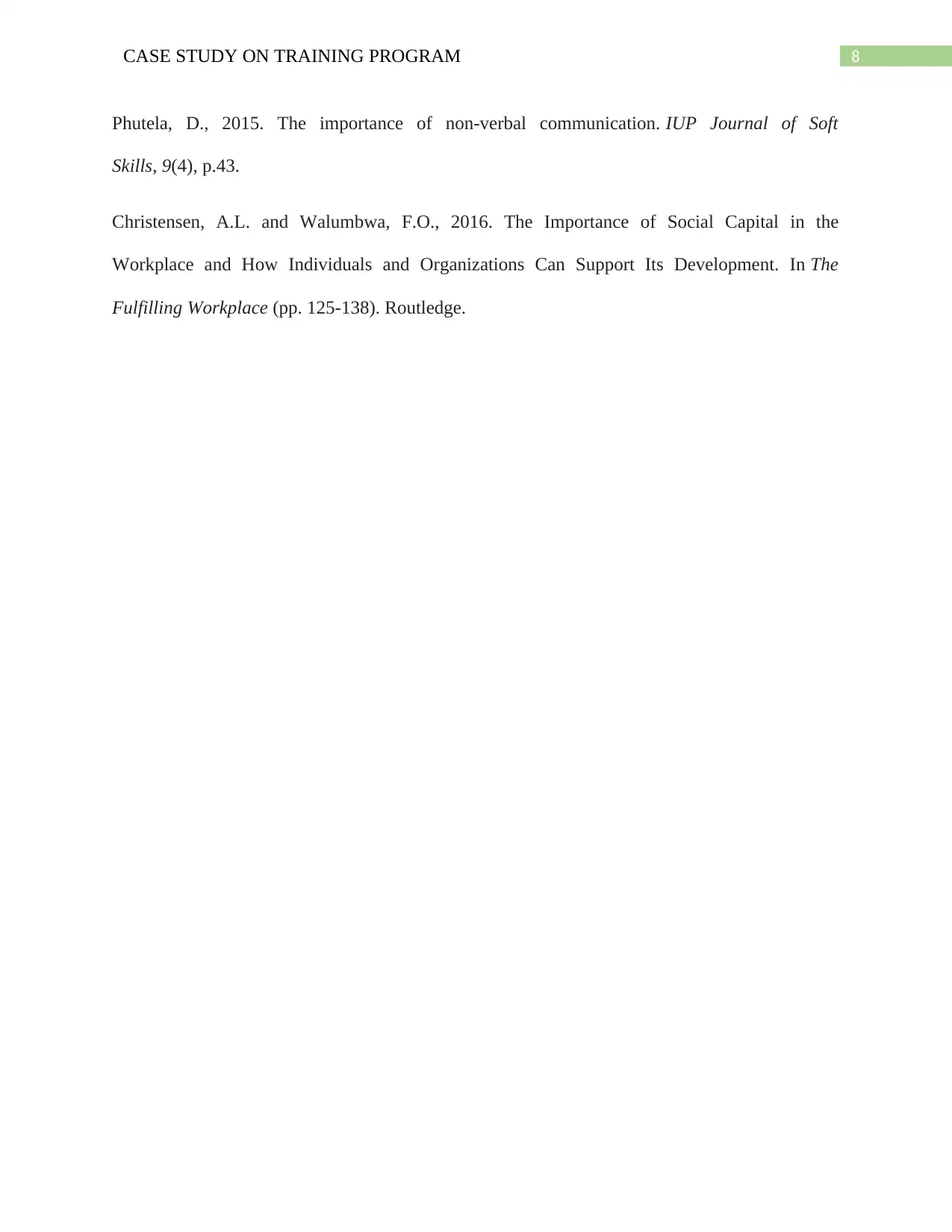
8CASE STUDY ON TRAINING PROGRAM
Phutela, D., 2015. The importance of non-verbal communication. IUP Journal of Soft
Skills, 9(4), p.43.
Christensen, A.L. and Walumbwa, F.O., 2016. The Importance of Social Capital in the
Workplace and How Individuals and Organizations Can Support Its Development. In The
Fulfilling Workplace (pp. 125-138). Routledge.
Phutela, D., 2015. The importance of non-verbal communication. IUP Journal of Soft
Skills, 9(4), p.43.
Christensen, A.L. and Walumbwa, F.O., 2016. The Importance of Social Capital in the
Workplace and How Individuals and Organizations Can Support Its Development. In The
Fulfilling Workplace (pp. 125-138). Routledge.
1 out of 9
Related Documents
Your All-in-One AI-Powered Toolkit for Academic Success.
+13062052269
info@desklib.com
Available 24*7 on WhatsApp / Email
![[object Object]](/_next/static/media/star-bottom.7253800d.svg)
Unlock your academic potential
© 2024 | Zucol Services PVT LTD | All rights reserved.





